Chapter 7. Energy and Energy Balance - PowerPoint PPT Presentation
1 / 15
Title:
Chapter 7. Energy and Energy Balance
Description:
Enthalpy ... Determine the specific enthalpies of each stream components. Using ... Heat flow, internal energy changes (enthalpy change) are most important ... – PowerPoint PPT presentation
Number of Views:726
Avg rating:3.0/5.0
Title: Chapter 7. Energy and Energy Balance
1
Chapter 7. Energy and Energy Balance
- ?????
- ???????
2
Introduction
- Energy is expensive.
- Effective use of energy is important task for
chemical engineers. - Topics of this chapter
- Energy balance
- Energy and energy transfer
- Forms of energy Kinetic / Potential / Internal
Energy - Energy transfer Heat and Work
- Using tables of thermodynamic data
- Mechanical energy balances
3
Typical problems
- Power requirement for a pump ? Pure mechanical
energy balance - Heat / Work calculation for a desired change
- Removal of heat from reactor
- Combustion problem
- Requirement of energies for each apparatus
4
7.1 Forms of Energy The First Law of
Thermodynamics
- Forms of energy
- Kinetic energy due to the motion of the system
- Potential energy due to the position of the
system - Internal energy due to the motion of internal
molecules - U from thermodynamic calculation
- Forms of energy transfer
- Heat (Q) energy flow due to temperature
difference - Work (W) energy flow due to the driving force
other than temperature difference (force, torque,
voltage, )
5
Energy balance on closed systems
- Balance equation
- (Final System Energy) (Initial System Energy)
- (Net Energy Transfer)
- Initial System Energy
- Final System Energy
- Net Energy Transfer
The first law of thermodynamics for closed systems
6
Important points
- U depends on composition, state, temperature of
the system. Nearly independent of pressure for
ideal gases, liquids, solids. - Q 0 ? Adiabatic process
- If there are no moving parts, W 0
- Potential energy change ? due to the changes in
height
7
7.2 Energy Balances on Open Systems at Steady
State
- Flow work and shaft work
- Flow work work done on system by the fluid
itself at the inlet and the outlet - Shaft work work done on the system by a moving
part within the system
Process Unit
8
Specific Properties
- Specific properties
- (Property) / (Amount (Mass, Mole number,))
- Volume , energy, ? Extensive properties
- Specific volume, specific energy, ? Intensive
property - Example)
- Volume extensive property ? depends on system
size - Specific Volume intensive property ?
independent of system size
Extensive properties
Intensive properties
9
Enthalpy
- It is convenient to define the following property
for the calculation of energy balance for flowing
systems. - Enthalpy
- Specific Enthalpy
10
The Steady-State Open System Energy Balance
11
7.5 Tables of Thermodynamic Data
- U, H, S, V, ? Thermodynamic function
- Tables of Thermodynamic Data
- Tabulation of values of thermodynamic functions
(U, H, V,..) at various condition (T and P) - It is impossible to know the absolute values of U
, H for process materials ? Only changes are
important ( DU, DH,) - Reference state
- Choose a T and P as a reference state and measure
changes of U and H from this reference state ?
tabulation
12
Steam Tables
- Compilation of physical properties of water
13
7.6 Energy Balance Procedures
- Solve material balance ? Get all the flow rate of
streams - Determine the specific enthalpies of each stream
components - Using tabulated data
- Calculation
- Construct energy balance equation and solve it.
14
7.7 Mechanical Energy Balances
- Chemical equipment (Reactor, Distillation
column, Evaporator, Heat exchanger,) - Heat flow, internal energy changes (enthalpy
change) are most important - Shaft work, kinetic energy, potential energy
changes are negligible - Mechanical equipment (Pump, Reservoir, Pipes,
Wells, Tanks, Waste Discharge,) - Heat flow, internal energy changes are negligible
- Shaft work, kinetic energy, potential energy
changes are most important
15
Mechanical Energy Balances
Bernoulli Equation
Important equation for the calculation Of
equipments consist of pipes, tanks and pumps































